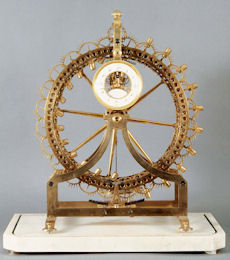

Mechanical energy includes: potential energy, also known as energy of position. The potential energy Epot of a mass m, for example, is equal to Epot = m g h, where g is the acceleration due to gravity and h is the height. Potential energy can be found in elastic deformation, in which the original shape of a material is recovered after an external force is removed.
There is also kinetic energy, also known as energy of motion, Ekin = ½ m v2, which arises from the motion of a mass m with a velocity v. Similar to kinetic energy of translation (the energy of moving from place to place) the rotational energy of a body with angular velocity ω and a moment of inertia Ⅰ with respect to the rotational axis is described by Erot = ½ Ⅰ ω2.
When mechanical energy is not converted to another energy form (other than potential energy), the principle of conservation of mechanical energy applies:
This describes, for example, the undamped vibration of a pendulum. An experimental proof of the conservation of mechanical energy is the fact that one cannot build a perpetual motion device.


The picture at the left is a replica (exhibited in the museum NAWCC) of a clock presented in 1815 by David Geiser as a perpetual motion device. After his early death in 1817, it became known that the device did not, in fact, run continuously.
The picture at the right depicts a thousand year old design for the construction of a continuously rotating wheel. It runs continuously indeed, but only on the Internet page www.hp-gramatke.de.